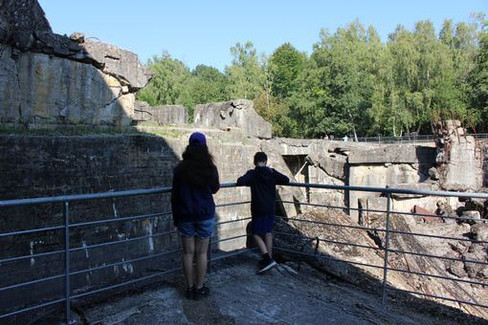THE BLOCKHAUS D'ÉPERLECQUES, SAINT-OMER, FRANCE
- Sarah

- Mar 10, 2022
- 4 min read
The Blockhouse at Éperlecques is situated in a leafy green forest near Saint-Omer, northern France and was built by the Germans in World War II as a V2 launching facility. It is a powerful and dramatic place to visit - off the main tourist trail and deep in beautiful woodland is this monstrous, concrete testament to the evils of the Nazi regime and the damage they inflicted on Europe.

The Blockhouse is not the easiest place to find. In the countryside about 20 miles from Calais, surrounded by small villages, acres of fields and woodland, the Blockhouse feels very much off the beaten path. Reached by just a single track road which deposits you in a gravelled car park with just a small reception building, you have no idea of what lies ahead.
The visit starts as you leave the reception area with a sign on the door (in all languages) telling you to go to the train, stand in a carriage and close your eyes. Entering the forest, we found the train, two wooden cattle carriages on a track. We got inside, stood on the assigned footprints, pressed the button for audio and closed our eyes.

There followed the awful soundtrack of people being herded aboard a train, a journey in a packed carriage, babies crying, and finally arriving at your destination to be greeted by the sound of vicious dogs barking. It was a journey to Buchenwald and for such a basic effect, it was incredibly poignant. It is simple enough to not be distressing for kids, but an easy way for them to gain some small understanding of the horror.

The rest of the site is a walk through the beautiful forest, following a path that takes you past sentry boxes, military vehicles, a pocket submarine, a satellite, beach defences and so much more, all emerging from the verdant background. Where there are benches, you can press a button to get an audio recording in several languages to tell you more about what you are looking at, which I thought was cleverly done and caters for everyone.
The area around you is pockmarked with craters from the bombing, now softened by the growth of the forest over them. There are shells embedded in the ground, this aged and rusted weaponry looking so benign peeking through the greenery. You tend to forget where you are, almost as if you are just enjoying a stroll through a pretty forest looking at museum pieces, when halfway through, you turn a corner and suddenly see the actual blockhouse - a truly huge, horrifying concrete box which towers above both you and the forest.
Twisted metal sticks out of the concrete walls high above, the ground has caved in around the base so that a sign saying ‘Eingang’ is far below you, which helps you to realize the sheer size and impressiveness of this hideous structure.
The site was heavily bombed by the Allies and much of it is still rubble, with rusted barbed wire dotted around, a narrow gauge train still on its tracks with sacks of now solid concrete onboard and nearby an abandoned crane where you can peer in and still smell the oil. Pools of stagnant water lie at the base of the blockhouse, some now have water lilies, as nature sprouts through the cracks and gaps to reclaim the land.
A small memorial has been created out of the concrete sacks on the railway, to the mainly Belgian prisoners who were transported here on cattle trains and forced to work on its construction. It is extremely moving.

With more audio points around to tell you in detail about the construction, the rockets and more, you sit on the benches in quiet awe looking at it. You can go inside too, through the 7ft thick steel doors and watch a film, again in several languages, see the places where the rockets were stored and listen to the drip of water, feel the cold dankness and continue to be amazed by the sheer size of the structure.

A visit to the site ends with a V2 rocket and a V1 rocket on its launching pad, both dramatic, horrific reminders of why the bunker was built.
It is an incredible place to visit. We found it visually stunning with its contrast of concrete and forest, the impressions of death in such a beautiful place. Our kids enjoyed it too, impressed by the size, the rubble and the areas to explore, it is a good opener for talking to kids about how Nazi Germany must have seemed invincible at the time, with these imposing concrete structures sprouting up across the country and colonising the once beautiful countryside, only 20 years after World War I. Even now, 80 years on and in a state of decay, they are imposing, imperial and ominous.
VISITING THE BLOCKHAUS AT ÉPERLECQUES
Opening Times 2022 March and October (closed on the 4th Sunday of October) 2 - 5pm April, May, June, September (last admission 3:45 p.m.) 11- 5:30 pm
July, August, (last admission 4:45 p.m.) 10 - 6:30 pm
Ticket Prices for 2022 Adult: €11 Child (8-14 yrs): €6.50 Children under 7: free Family ticket: €33
English translations are available on all signage and interpretation boards as well as the films and audio. Visit when it opens to have the place mostly to yourselves so you can select the English version for the audio and films without having to wait too long.
The site is pushchair and wheelchair accessible.
Free parking is available on site.




















Comments